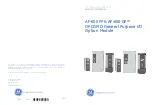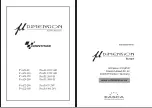
SECTION 1: INTRODUCTION
LAON Technology („LAON‟) is a leading-edge technology developer and innovative solutions provider in Digital Wireless Audio
Communications and Wireless Intercom Systems.
LOAN‟s digital wireless Intercom System, LT250 operates in license-free 5GHz UNII band securing high performance wireless
coverage
and scalability. And LAON‟s technologies such as non-compressed audio transmissions, triple diversity (3D), noise
cancelling and automatic interference avoidance realized to enable our high standard intercom users to experience break-up free
audio communications. LT250 provides a full flexibility on grouping allowing up to three (3) communication group channels to be
allocated with up to nine (9) full-duplex audio paths
– eight (8) channels for Belt Pack and 1 (one) channel for Base Station. It also
maintains the audio clarity high in quality even in noisy environments and guarantees private and secured communications by AES
256bit Level-3 encryption. More details to be followed;
Up to 32 Belt Packs can be paired up with each Base Station in the normal mode and additional 96 Belt Packs can be paired up
under the shared mode. Those Belt Packs under the shared mode operate only in
„Push-to-Talk‟ mode. 32 Belt Packs with which
have been paired up with Base Station in the normal mode can be monitored, and additional 96 Belt Packs with which have been
paired up in the shared mode cannot be monitored at the Base Station.
Up to three (3) communication groups, single or multiple, can be allocated and configured flexibly to the Base Station, Belt Pack
and Auxiliary input/output. The communication group allocation to Belt Packs, Auxiliary input/output and the Base Station itself can
be set each by the Base Station operator using the Base Station menus.
As shown from the figure,
„Communication group allocation‟ of the System Usage Example below, for instance, you may allocate
only one group to Belt Pack # 1 (Group # 1 for BP1), two groups to Belt Pack # 3 (Group # 1 & 2 for BP3) and all the three (3)
groups to Base Station (Group # 1, 2 & 3 for Base Station).
Belt Packs and other devices in the same communication group can talk with others in the designated group. The selected
communication group is displayed on the NORMAL
menu of the Belt Pack as “1” through “3”.
Base Station and Auxiliary devices can communicate at the same time with all the groups allocated up to three (3). The selected
communication group is displayed on the NORMAL menu of the Base Station
as “1” through “3” and “A”.
Remote Base Station (RBS) can be connected to the Base Station through LAN, composing customized and continuous coverage,
and enabling automatic roaming between coverage zones. The Remote Base Station supports the communications with Belt Packs
in remote area from the Base Station and shares up to nine (9) full duplex audio paths with the Base Station within the coverage
area. Standard CAT-5 cable is used to connect the Remote Base Station either directly to the LAN port on the rear panel of the
Base Station, or via network switch. Remote Base Station can be powered by local electricity or network switching devices which
has the Power-over-Ethernet (POE) function. Due to network traffic delay, audio breakups might occur in communications between
Belt Packs in the Remote Base Station coverage, or in communications with Belt Packs which are connected to the Base Station. In
that case, it is recommended to compose the network exclusively.
OLED displays on the front panel of the Base Station and Belt Pack are for setting up operations and monitoring. The Base Station
can monitor connectivity status among the Base Station, Remote Base Station and Belt Packs. Moreover, the Base Station can
mon
itor each Belt Pack‟s Received Signal Strength Indication (RSSI) level, battery level and microphone gain.
The USB port on the rear panel of the Base Station is supposed to be used for communication with PC to exchange data and
update programs.
5






































